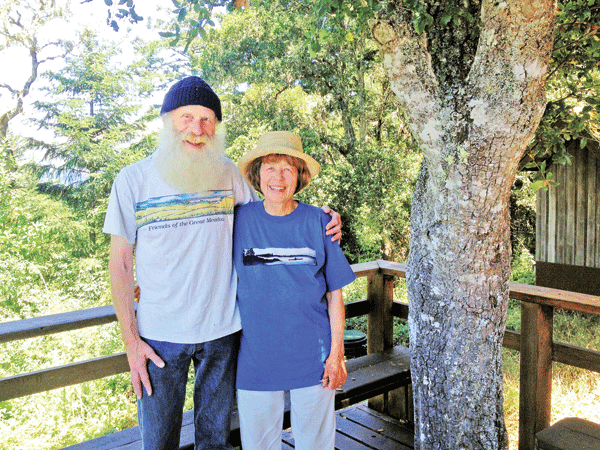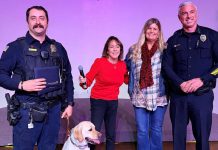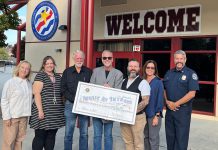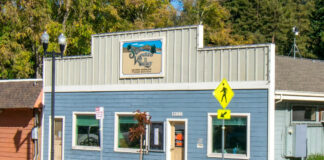A piercing raptor’s cry comes out of the sky and disrupts the peace along Spring Trail in Pogonip. Peter Scott calls out, “Red-shouldered hawk!”
Spring Trail was one of the first roads in Santa Cruz. Built by Henry Cowell — once the largest land owner in California — the wagon trail was used to connect his vast empire of ranching, logging, and quarrying sites in the 1850s and 60s.
Today I am walking the trail with local environmental heroes, physicist Peter Scott and his wife Celia, the former Santa Cruz mayor and environmental attorney, and learning about what was and what might have been on this halcyon hill.
After graduating from Massachusetts Institute of Technology, Celia moved to England and studied the green belt that grew all around the city of London.
“I realized it was possible to have open space right into the heart of a city,” she said.
She remembers moving to California at a pivotal time for Pogonip’s future.
“Pogonip was being proposed as a major urban development in 1969. I and a lot of other people realized we didn’t want that. We started a political movement and managed to get a measure on the ballot against the will of the city, not exactly environmentally-oriented in the early 1970s.”
The measure created the Santa Cruz Greenbelt with Pogonip as the crown jewel. The group managed to get the city to acquire it in a bond act in 1989. The couple has been leading hikes in Pogonip ever since.
One of her favorite achievements as mayor was creating a master plan for Pogonip which involved years of meetings and committees, of which Peter was involved, to decide what would be the management framework.
Pogonip means “ice fog” but the word does not come from this area but from the eastern side of the Sierras. For instance, the fog at Mono Lake is called a “Pogonip fog” which occurs when the weather turns “icy.”
“That shows you that the people who inhabited this region must have gone back and forth and that name was carried down through all those years to modern times,” says Celia.
“This limestone rock here is at the edge of the Ben Lomond earthquake fault,” Peter points out. “Look how steeply the hill goes down. It dominates this side of Ben Lomond Mountain and provides the channel for the San Lorenzo River.”
Peter theorizes that “the geology determines the sociology of the place. The people who live in Scotts Valley are different from the people who live in the San Lorenzo Valley who are different than the people who live in Santa Cruz. If there were a level plain, there wouldn’t be such a difference. When you go out in the Central Valley, the land is flat and there isn’t much difference between the communities.”
Through a break in the big leaf maples, Celia points out the Loma Prieta Peak, the highest point in the Santa Cruz Mountains at 3,786 feet. We look at the great meadow below where they used to play golf and polo, and the Pogonip Club House, where they filmed the movie “Lost Boys” with Kiefer Sutherland.
She says that the city has unfortunately abandoned the building.
“They had a grant to restore it but they had to match it and they failed to do it. It’s a gorgeous building but it’s just been mothballed for a long time. When that was private property that was the social hub.”
Beyond the club house a trajectory of trees hide the San Lorenzo River as it flows out of the mountains and to the bay.
We walk by a limestone cliff created by dynamite for the old quarry. The space harbors a small stone labyrinth created by an unknown passer-by. Peter says that individuals change the symbol every week and that people come here to meditate.
Along with helping to save Pogonip, Celia has been active in coastal protection, too, and worked to get the California Coastal Act created in 1972.
“It set up a regulatory system to protect the whole California coast line from San Diego to the Oregon border,” she said.
Recently she spent two days before the Santa Cruz City Council urging them to not weaken the Heritage Tree Ordinance.
“They didn’t agree with me,” she said. “At least so far anyway.”
Celia says of Pogonip, “It’s an opportunity for people who live in an urban area to walk right out into nature. It brings nature almost into the heart of the city. And that was one of the greenbelt principles that I learned about when I was in England. A city doesn’t have to be isolated from nature, and nature can be a refuge for people who want to still connect to nature, if you can bring it close in so you don’t have to drive 20 miles to get to a place to go for a walk.”
Join the Scotts and me for a walk on Spring Trail on Oct. 19. This is part of a series of free nature walks I have created for the last five years with an environmental education grant provided by the San Lorenzo Valley Water District. Contact me for more information at ca****@*********on.com.
– Carol Carson, M.Ed., is a writer, naturalist, and educator.













